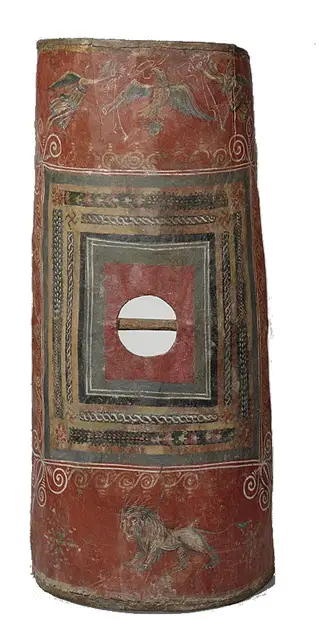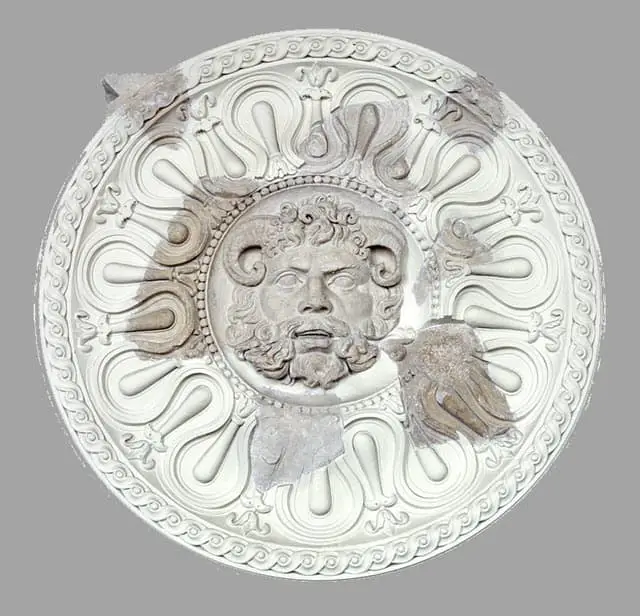The Romans were famous for their most creative and innovative Roman Battle Tactics. The Roman army and the soldier used specific weapons, military clothing, shields, and battle tactics.
The shields used by the Roman army were unique and practical, which proved to be the main reason behind numerous victories during wars. They were mostly made out of wood, where the wood was turned into varieties of shapes.
Despite having numerous shields, the Roman armies preferred three powerful shields: Legionnaire Scutum, Clipeus, and Parma.
However, the Scutum was the most used and highly effective, which began in the 4th Century BC. It was well-known for its Testudo formation and was commonly used in almost every battle of the Romans.
The Roman shields have also inspired the shield used in the modern world. The tortoise and Auxiliary shields are two examples of them.
Here is detailed information about the three effective shields used by the Roman Army.
The Legionnaire Scutum
Content

Source: Wikimedia Common
The legionnaire Scutum is the most famous Roman shield used by the Roman army in almost all wars.
Initially, this shield was used by the Italic Antiquity and was adopted by the Roman army during the 4th Century. The shape of the shield differed from the shapes seen in later days.
In the beginning, the shield was oval and flat, which was changed into a rectangular and curved shape during the invasion of Britain in 43 AD.
The shield was made with one-layered wood in the initial days, but the enemies could easily poke the shield and hurt the Roman army with their weapons.
A considerable number of the Roman Army was injured during the Roman campaign against the Dacia and Carthage.
Since then, the shields were made with two to three layers of wood attached. Strips of wood were also connected with glue from the sides of the flat wood to give a curve shape and protect the army from all around.
The layered wood would then be covered with leather, and a sheet of linen cloth with the front side printed to look attractive. The most common print used on these shields was the eagle’s wings or the lightning bolt made of metal.
The eagle’s wings would symbolize the Roman army, whereas the lightning bolt would symbolize one of the ancient Roman gods, the King of God, Jupiter.
Scutum was made for the foot soldiers as it protected them from all sides. The soldiers used this shield mostly in the Testudo Formation, one of the Roman Battle Tactics. They would carry the shield and align them on both front and top portions.
Though the shield was effective and could protect the soldiers from all sides, it was heavy and challenging for the hand movements. It weighed between 5.8 kgs to 6.8 kgs and had dimensions of 105.5 cm in height, 41 cm across, and 30 cm deep.
In 27 BC, the golden scutum was awarded to one of the greatest Roman Emperors, Emperor Augustus, by the senate for playing a vital role in ending the civil wars and restoring the republic.
However, out of all the Roman scutum, only one piece was found in good condition at one of the Roman forts in Syria – Dura Europos.
Clipeus

Source: Wikimedia Common
Clipeus, a shield inspired by the Greek Aspis, was the shield used before the Scutum. It was a large, round shield worn by the Roman army as defensive armor.
The central portion of the shield had a bolt of iron with a sharp point, known as umbo, to protect the army and harm the enemy during battles. This shield was used by carrying it upon the arm and blocking the attacks of the enemy.
The shield was mainly used during the Roman Kingdom and the early Republic. It was used effectively until the Scutum replaced it.
It was initially used by Proetus and Acrisius of Argos and named Clipeus Argolicus.
Parma

Source: Wikimedia Common
The Roman Army used Parma during the 3rd Century around the end of the Imperial Roman. Parma was also known as Parmula and was round in shape.
It had a total area of 91 cm and was framed with iron to protect the enemy’s attack.
Parma was made for the lowest class of armies, the Velites. They would carry helmets, swords, javelin along with the Parma.
The shield was used mainly by the auxiliary infantry and cavalry during wars and Roman Gladiators, especially the Thraex Gladiators.
Unlike other Roman shields, the Parma was famous for other uses apart from the wars and campaigning. It was used in a Pyrrhic dance, a famous dance form of the Greeks, and was also carried by the Roman flag bearer.
However, with the change in the battle tactics, the Velites were replaced with the Marian reforms, and so was the Parma replaced with Scutum. The army, in some cases, would still choose parma over scutum if they preferred to carry heavy and effective shields.
Conclusion
The Romans invented numerous tactics, weapons, shields, architectures, scripts, and other essentials things. They never lacked behind in creating something that they required and could result efficiently.
Though they were in less number, the shields proved to be the Romans’ most influential inventions and creations. The shields helped the Roman army to gain victories over numerous enemies and enemy nations.
They proved efficient during the Roman Era and inspired and influenced other Empires and the modern world to invent needed pieces of equipment.
